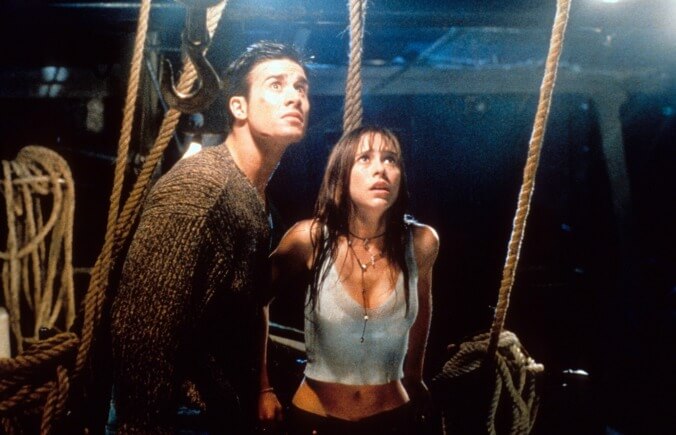I Know What You Did Last Summer turns 25: Why a murderous fisherman hooked so many moviegoers
Kevin Williamson's Scream follow-up gathered '90s heartthrobs like Jennifer Love Hewitt, Freddie Prinze Jr., and Sarah Michelle Gellar—and killed most of them

Blame Scream for the vice grip that I Know What You Did Last Summer had on pop culture 25 years ago this month.
With the success of director Wes Craven and then-newbie screenwriter Kevin Williamson’s horror hit, which revitalized the slasher genre, Hollywood was eager to pack multiplexes with more scary movies about teenagers struggling to outrun and unmask a relentless, stab-happy killer. With a script by Williamson (based on Lois Duncan’s 1975 book of the same name), and a Peak ’90s teen heartthrob cast—Jennifer Love Hewitt, Sarah Michelle Gellar, Ryan Phillippe, and Freddie Prinze, Jr.—I Know What You Did Last Summer was rushed into production by Columbia Pictures and a mini-phenomenon was born, one whose impact still resonates (because nostalgia) 25 years after introducing audiences to a hook-wielding fisherman.
Whereas Scream walked a very effective tonal tightrope with its self-referential humor, Williamson adapted Duncan’s storyline to resemble more of an ’80s slasher thriller—the kind of movie that, ironically, Scream satirized. Critics were mixed on the end result (the film has a 44% on Rotten Tomatoes), but audiences were not. They made Summer a box office hit ($125.3 million worldwide, on a $17 million budget). And despite the movie’s narrative shortcomings, fans have helped Summer maintain its cultural imprint.
From turning one of its more iconic scenes into a meme to convincing Hollywood that their passion for the OG movie warranted a (meh) limited series adaptation/reimagining of the source material for Amazon Prime Video, Last Summer’s passionate pocket of fandom has kept this cornerstone of ’90s horror thriving, in part because it offers a big helping of re-watchable nostalgia porn.
Whether you saw it with your high school pals on opening weekend, or discovered it later in life on cable, DVD, or streaming, Last Summer’s continued appeal seems to be largely found in its time-capsule, guilty-pleasure roots. It can’t be the plot, which has more holes than some of the film’s victims. Even die-hard fans still scratch their heads as to why the Fisherman kills the kid from Big Bang Theory (Johnny Galecki) who has no ties to what happened to the killer or his homicidal vendetta, which is sparked when a small fishing town’s privileged teens—Julie James (Hewitt), Helen Shivers (Gellar), Barry Cox (Phillippe) and Ray Bronson (Prinze, Jr.)—strike down their future tormentor in a hit-and-run accident over July 4th weekend.
As in-fighting rages among the guilty teens, the body count increases, as does the number of red herrings that don’t lead anywhere and don’t service the story. And the tried-and-true horror movie trope of having an inept police force investigate a string of serial killings reaches a new level of incompetence here, when Helen tells the cops about a murder that they don’t appear to follow up on. Nor do they appear remotely concerned after the film’s bloody climax, when Julie has seemingly defeated the killer and they find a boat full of fresh corpses.
But, as bumpy as the narrative road is to Last Summer’s inevitable conclusion, the ending (and the shocking final twist before the end credits) is a mostly satisfying one. It checks all the boxes by becoming a two-hander in which our heroic (and, sadly, over-sexualized) Julie and her somewhat estranged beau, Ray, team up to defeat the killer and then reconcile their relationship. The two are temporarily safe in the feeling that, even though the consequences of their actions made their core friend group extinct, hey, at least they didn’t kill anyone during that hit-and-run.
Slasher flicks follow an “only-in-the-movies” sense of story logic like the above that often defies how people in the real world would behave in situations like those depicted here. But what helps audiences forgive them, or, at the very least, not let it get in the way too much of enjoying their popcorn, are the reasons why those audiences bought a ticket to begin with: the kills. And, on that front, Last Summer delivers.
Williamson’s script, and Jim Gillespie’s direction, wisely know to get out of the way every 10 to 15 minutes and let the murder-y set pieces do their thing. Last Summer’s most effective, and disturbing, kill is one of the best from ’90s horror: At the town’s beauty pageant (because reasons), a helpless Helen watches Barry get murdered on a balcony. This tragedy leads to more moments later, when Helen leads the killer to her sister, Elsa (Billy Madison’s Bridgette Wilson), and he kills her before slashing a screaming Helen to death.
This horrifying sequence elevates Last Summer above the other Scream wannabes that flooded theaters in the back half of the ’90s and early 2000s. (*shakes head at Disturbing Behavior*). The reason why those films struggled to make an impact, or rise above their DVD-bargain-bin status, is largely because they forgot to invest their kills with characters we care about, or, at the very least, characters played by charming actors that we can’t help but care about. Actors that took advantage of their time off between their regular TV gigs to do a “Horror Hiatus” movie. Last Summer is arguably the best example of what that fair-to-middling gluttony of movies attempted.
Most of them failed, but the ones that succeeded—like Summer—knew that success hinged on a winning formula of appealing, attractive stars plus effective scares.
I Know What You Did Last Summer is not a great movie, but it is a great time at the movies. There isn’t a better time to see how well that assessment holds up than on its 25th anniversary. As Julie would say, “What are you waiting for?!”